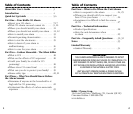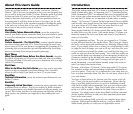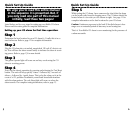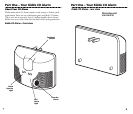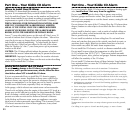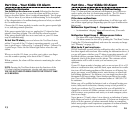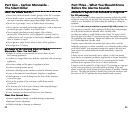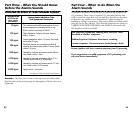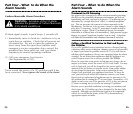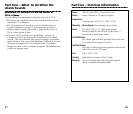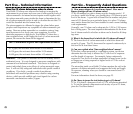
Part One – Your Kidde CO AlarmPart One – Your Kidde CO Alarm
Where to Install Your CO Alarm
Your Kidde CO alarm should be mounted in or near bedrooms and liv-
ing areas. It is recommended that you install a Kidde CO alarm on each
level of a multi-level home. You may use the number and location of
smoke alarms installed in your home according to current building code
requirements as a guide to the location of your Kidde CO alarm(s).
WHEN CHOOSING YOUR INSTALLATION LOCATIONS, MAKE
SURE YOU CAN HEAR THE ALARM FROM ALL SLEEPING
AREAS. IF YOU INSTALL ONLY ONE CARBON MONOXIDE
ALARM IN YOUR HOME, INSTALL THE ALARM NEAR BED-
ROOMS, NOT IN THE BASEMENT OR FURNACE ROOM.
Seven (7) years after initial power up, this unit will "chirp" every 30
seconds to indicate that it is time to replace the alarm. After seven
years the device may no longer detect carbon monoxide accurately
and should be replaced immediately. To help identify the date to
replace the unit, a label has been affixed to the side of the alarm.
Write the "Replace by" date (7 years from power up) in permanent
marker on the label.
CAUTION: This CO alarm will only indicate the presence of carbon
monoxide at the sensor. Carbon monoxide may be present in other areas.
IMPORTANT: Improper location can affect the sensitive electronic
components in this CO alarm. Please see the next section describing
where NOT to install this CO alarm.
If you must install a Kidde CO alarm near a cooking or heating appli-
ance, install at least 5 feet away from the appliance.
Do not install in excessively dusty, dirty or greasy areas such as
kitchens, garages and furnace rooms. Dust, grease or household
chemicals can contaminate or coat the alarm’s sensor, causing the unit
not to operate properly.
Do not obstruct the vents of the CO alarm. Place the CO alarm where
drapes, furniture or other objects do not block the flow of air to the
vents.
Do not install in dead air space, such as peaks of vaulted ceilings or
gabled roofs, where carbon monoxide may not reach the sensor in
time to provide early warning.
Do not install in turbulent air from ceiling fans. Do not install near
doors and windows that open to the outside, near fresh air vents, or
anywhere that is drafty. Rapid air circulation from fans or fresh air
from outside may affect the unit’s alarm response time.
Do not install this CO alarm in a switch- or dimmer-controlled outlet.
Do not install in areas where the temperature is colder than 40˚F
(4.4˚C) or hotter than 100˚F (37.8˚C). These areas include uncondi-
tioned crawl spaces, attics, porches and garages. Extreme temperatures
will affect the sensitivity of the CO alarm.
Do not install CO alarm near deep cell large batteries. Large batteries
have emissions that can cause the CO alarm to perform at less than
optimal performance.
The following conditions can result in transient CO situations:
Excessive spillage or reverse venting of fuel-burning appliances caused by:
• outdoor ambient conditions, such as wind direction and/or velocity,
including high gusts of wind, and insufficient draft in the vent pipes;
• negative pressure differential resulting from the use of exhaust fans;
• simultaneous operation of several fuel-burning appliances competing
for limited internal air;
•loose vent pipe connections from fuel-fired appliances;
• obstructions, or unconventional vent pipe designs that can amplify
the above situations;
•poorly designed or maintained chimneys and/or vents;
Extended operation of unvented fuel-burning devices (range, oven,
fireplace, etc.);
Temperature inversions that can trap exhaust gasses near the ground;
and a
Car idling in an open or closed attached garage, or near a home.
Where Not to Install Your CO Alarm
To avoid causing damage to the CO alarm, to provide optimum
protection, and to prevent unnecessary alarms, follow the direc-
tions below where NOT to install this CO alarm:
It is not recommended that you install this CO alarm in garages,
kitchens or furnace rooms. Installation in these areas could lead to
nuisance alarms, may expose the sensor to substances that could
damage or contaminate it, or the alarm may not be heard by persons
in other areas of the home, especially if they are sleeping.
In the garage, vehicle exhaust can contain some carbon monoxide.
These levels are higher when the engine is first started. CO levels in a
garage may not be sufficient to activate the alarm immediately. Within
hours of starting a vehicle and backing it out of the garage, the levels
present over time can activate the alarm and become a nuisance.
In the kitchen and furnace room, some gas appliances can emit a
short burst of carbon monoxide upon startup. This is normal. If your
CO alarm is mounted too close to these appliances, it may alarm
often and become a nuisance.
12
11




